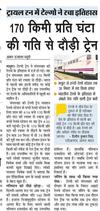The speed vs weight vs length is actually a very messy calculation. The locomotive is powered. Even if it is heavy, it can generate enough power to run at required speeds. And when a locomotive is running alone without any coaches, it can generate more than enough power to haul itself alone.But the coaches are dead weight and depend on the locomotive to haul them at the required speed. Now, the locomotive has an upper limit on the amount of power it can generate. So, naturally a lighter rake can be hauled at higher speeds for the same power. Just to give an idea, the 9 coach Talgo rake that was tested, weigh's only 1.5 times that of the WDP4 loco that hauled it, and weighs a little over a 5 coach LHB 3AC rake.
...
more... In addition, LHB coaches are longer, which would mean higher lateral forces on curves. Because of this, if the tracks have to support higher speeds with LHB rakes, then many curves must be corrected and sharp turns have to be opened up and made into smoother turns. This was the reason why Gatimaan is restricted to such a short rake and BPL Shatabdi is not upgraded to higher speeds even though the rolling stock is fit to be upgraded.
This was the main selling point of Talgo, as the coach design is in such a way that little to no change is required in the tracks, bridges etc on IR's network to run the trains at higher speeds.
Another point that is rarely mentioned when comparing the Talgo rolling stock with the LHB stock is the carriage height from the rails. Contrary to popular opinion, having a streamlined locomotive ( an aerodynamic face like the WAP5,WAP4 etc) is not really necessary for trains at moderate to high speeds, as even a flat face will not generate much air resistance. The main air resistance comes from the wind blowing below the coach ( through the gap between the rails and the bottom of the coach. For this reason, high speed trains usually have very low ground clearance. Talgo coaches are similar and have a smaller ground clearance than LHB coaches. While it is possible to still run LHB coaches at 200kmph (They are mechanically perfectly capable of tolerating high speeds), it will cost more and require more powerful locomotives than the Talgo coaches do. It will also require several track modifications to withstand the forces generated by the longer, heaver rakes.




